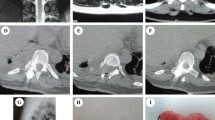Abstract
Background
Nineteen patients with cervical dumbbell tumors treated surgically were analyzed retrospectively.
Methods
Surgical strategies for dumbbell tumor were discussed from the perspective of safe, less-invasive surgery.
Results
Patients included 6 men and 13 women, with a mean age at the time of surgery of 48.3 years (range, 25–70 years). Underlying pathologies included 16 schwannomas, 2 neurofibromas, and 1 double tumor (schwannoma and meningioma). According to Eden’s classification, one patient was classified as Type 1, 5 as Type 2, 8 as Type 3, and 5 as Type 4. In 13 cases, tumors were excised through the posterior approach alone, compared to five cases using the anterior approach. One case was excised using combined anterior and posterior approaches. Facetectomy was not performed in 18 cases. In one case, the facet joint on one side had already destroyed and needed instrumentation. Tumors were totally excised in all cases. Postoperatively, the patients did not display any further neurological deficit, with the exception of transient radiculopathy in two patients. Major surgical complications and cerebrospinal fluid leakage were not seen. Tumor recurrence and spinal segmental instability were not found during follow-up period (mean, 41.6 months).
Conclusions
Dumbbell tumor surgery requires sufficient debulking of the epidural and paravertebral mass, using intraoperative nerve stimulation and Doppler ultrasonography to detect the vertebral artery. When using a posterior approach, recapping laminoplasty using an ultrasonic bone curette is very useful to remove tumor without sacrificing facet joints.


Similar content being viewed by others
References
Asazuma T, Toyama Y, Maruiwa H, Fujimura Y, Hirabayashi K (2003) Surgical strategy for cervical dumbbell tumors based on a three-dimensional classification. Spine 29:E10–E14
Eden K (1941) The dumb-bell tumors of the spine. Br J Surg 28:549–570
Iwasaki Y, Hida K, Koyanagi I, Yoshimoto T, Abe H (1999) Anterior approach for dumbbell type cervical neurinoma. Neurol Med Chir (Tokyo) 39:835–840
Jiang L, Lv Y, Liu XG, Ma QJ, Wei F, Dang GT, Liu ZJ (2009) Results of surgical treatment of cervical dumbbell tumors. Spine 34:1307–1314
Kim JH, Han S, Kim JH, Kwon TH, Chung HS, Park YK (2008) Surgical consideration of the intraspinal component in extradural dumbbell tumors. Surg Neurol 70:98–103
Kyoshima K, Uehara T, Koyama J, Idomari K, Yomo S (2003) Dumbbell C2 schwannomas involving both sensory and motor rootlets: report of two cases. Neurosurgery 53:436–440
Matsuoka H, Itoh Y, Numazawa S, Tomii M, Watanabe K, Hirano Y, Nakagawa H (2012) Recapping hemilaminoplasty for spinal surgical disorders using ultrasonic bone curette. Surg Neurol Int 3:70
Ozawa H, Kokubun S, Aizawa T, Hoshikawa T, Kawahara C (2007) Spinal dumbbell tumors: an analysis of a series of 118 cases. J Neurosurg Spine 7:587–593
Sugawara T, Itoh Y, Hirano Y, Higashiyama N, Shimada Y, Kinouchi H, Mizoi K (2005) Novel dural closure technique using polyglactin acid sheet prevents cerebrospinal fluid leakage after soinal surgery. Neurosurgery 57:290–294
Tomii M, Itoh Y, Numazawa S, Watanabe K, Hirano Y, Nakagawa H (2009) Some pointers for the surgical management of spinal extradural schwannoma. Spinal Surg (Jpn) 23:259–264
Uede T, Kurokawa Y, Wanibuchi W, Piao HZ, Hashi K (1996) Surgical approach for cervical dumbbell type neurinoma: posterior approach by partial hemilaminectomy with preservation of a facet joint. No Shinkei Geka (Jpn) 24:675–679
White AA III, Johnson RM, Panjabi MM, Southwick WO (1975) Biomechanical analysis of clinical stability in the cervical spine. Clin Orthop Relat Res 109:85–96
Acknowledgments
The authors report no conflict of interest concerning the materials or methods used in this study or the findings specified in this paper. And the authors have no personal financial or institutional interest in this research described in this article.
Conflicts of interest
None.
Author information
Authors and Affiliations
Corresponding author
Rights and permissions
About this article
Cite this article
Tomii, M., Itoh, Y., Numazawa, S. et al. Surgical consideration of cervical dumbbell tumors. Acta Neurochir 155, 1907–1910 (2013). https://doi.org/10.1007/s00701-013-1787-9
Received:
Accepted:
Published:
Issue Date:
DOI: https://doi.org/10.1007/s00701-013-1787-9




